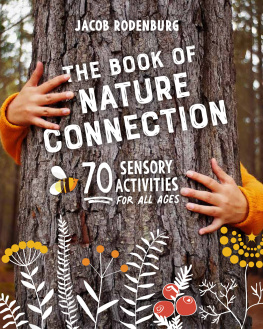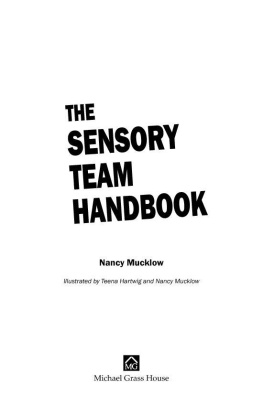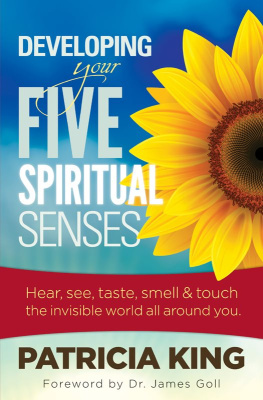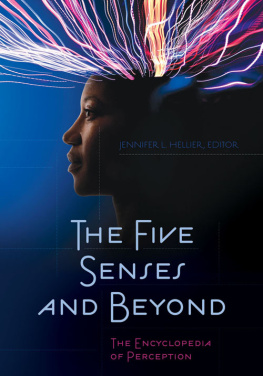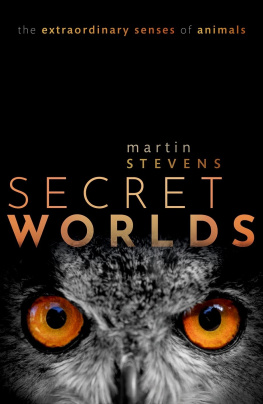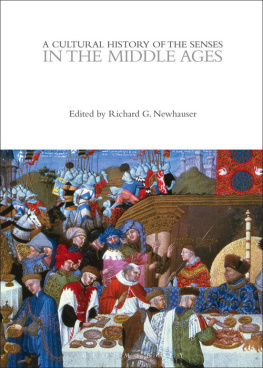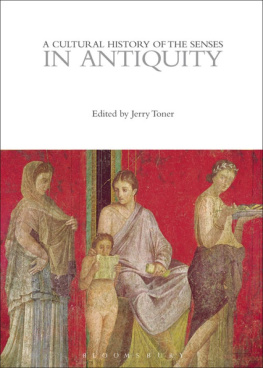A Tour of the Senses
A Tour of the Senses
HOW YOUR BRAIN INTERPRETS THE WORLD
John M. Henshaw

2012 The Johns Hopkins University Press
All rights reserved. Published 2012
Printed in the United States of America on acid-free paper
2 4 6 8 9 7 5 3 1
The Johns Hopkins University Press
2715 North Charles Street
Baltimore, Maryland 21218-4363
www.press.jhu.edu
Library of Congress Cataloging-in-Publication Data
Henshaw, John M.
A tour of the senses : how your brain interprets the world / John M. Henshaw.
p. cm.
Includes bibliographical references and index.
ISBN-13: 978-1-4214-0436-3 (hardcover : alk. paper)
ISBN-10: 1-4214-0436-2 (hardcover : alk. paper)
1. Senses and sensation. 2. Perception. I. Title.
BF233.H46 2012
152.1dc23 2011021306
A catalog record for this book is available from the British Library.
Special discounts are available for bulk purchases of this book.
For more information, please contact Special Sales at 410-516-6936 or
specialsales@press.jhu.edu.
The Johns Hopkins University Press uses environmentally friendly book materials,
including recycled text paper that is composed of at least 30 percent
post-consumer waste, whenever possible.
To Dad For making sense of it all
Acknowledgments
I wish to thank the staff of the Johns Hopkins University Press for their help at every stage of this book. My students at the University of Tulsa, the most important component of my professional life, deserve special mention for having inspired this book and for providing many of its anecdotes.
A Tour of the Senses
Introduction
If You Are Lucky
If you are lucky, this is what you were born with: two eyes, two ears, a nose, a tongue, a balance mechanism in your inner ear, and a layer of skin brimming over with all kinds of sensors. If you are lucky, all are in good working order and correctly wired to your brain, which is itself continually improving its ability to process and interpret the flood of information those instruments provide.
The eyes are about halfway from the bottom of the chin to the top of the skull. Lidded and lashed for protection, these superb optical instruments distinguish millions of colors, instantly recognize faces, function in conditions varying from near darkness to intense brightness, and sort out, unaided, tiny differences between particles much smaller than a grain of sand.
On either side of the head, at about the same level as the eyes, are the ears. The exterior parts, somewhat comical-looking and formed of cartilage, aid and protect the marvelous auditory instruments inside. The ears allow the brain to distinguish and interpret sound waves whose pressures and frequencies vary over astonishing ranges.
Centered below the eyes is the nose, and just below that the tongue, sheltered inside the mouth. Often working in concert, these two instruments sort molecules based on their smell and taste. The nose can distinguish about ten thousand different odors, protecting us from danger and enhancing our quality of life in countless ways. The tongue is at once the last sense guarding the body from poisons disguised as nourishment and an organ of immense sensual pleasure.
In the inner ear, next to the hearing organ, a set of fluid-filled instruments monitors the movements of the head with amazing fidelity. With no visible external parts, the vestibular system, as it is called, is surely the most underappreciated of the sense organs, although its duties could scarcely be more vital.
Last but hardly least, touch is our most extensive sense, covering as it does most of our bodywherever there is skin. At its most sensitive in the fingertips, it allows the blind to read and everyone to distinguish thousands of different textures. But thats only the beginning. Receptors in the skin and elsewhere also sense temperature, pain, and, of enormous importance, the position of the various parts of the body.
All of this superb instrumentation is useless by itself. The data gathered must be filtered, reconstructed, and interpreted, and that is the job of the brainitself mysterious in many ways, but becoming better understood all the time.
These are our senses. There are more than five, but whos counting? Each sense organ is an instrument of surpassing grace, efficiency, and versatility that converts external stimuli into electrical signals that are acted upon by our conscious and unconscious selves, in ways we have yet to completely comprehend, through the offices of our central nervous system and our brain, the most magnificent organ of all.
From the moment we are born, and even before, we develop and grow intellectually, socially, and emotionally by bringing information to our brain through our senses. And for most of our history as a species, the natural senses have been unrivaled, by any contrivance of humankind, in their ability to provide us information and knowledge. That has begun to change, as more and better sensing devices are developed. Some, such as cochlear implants, help restore a missing or deficient sensory ability inside the human body. Othersand here the list is very long indeedwork independently, such as the automated face-recognition systems to identify terrorists and other criminals.
Advances of these kinds will continue to change our lives. There are the obvious benefits to persons with disabilities, to medical professionals, and to law enforcement personnel. But this revolution in sensory instrumentation also has consequences for human development and for education. Why, for example, should a child learn to draw when high-quality digital cameras are so cheap and simple to use? Why should a medical student learn to palpate (feel with his fingers) a patients body, when so many powerful instruments are available to give him the same information and more? Why should an aspiring acoustical engineer listen to performances in a concert hall, when all he really needs to do is set up his instruments properly and let them listen for him? To these and similar questions, my answer is that the task of educating and protecting our senses is as important as it ever was and that we de-emphasize it at our peril. That the adults senses are so much more refined than those of a baby is a result of education, both formal and informal. Destructive forces lurk, however, as our senses are daily assaulted by unwanted noise, omnipresent video screens, and noxious odors.
Come along with me as we take stock of the sensory gifts we were given, of what we have learned how to do, through technology, to aid or improve the senses (and how such technology is likely to change), and of where this leaves us, in terms of interacting with the world around us. Having completed my own tour of the senses, I confess to an overwhelming sense of awe at the magnificent gifts we have been given. In spite of the astonishing rate at which science continues to unravel their mysteries, what we dont know about our senses sometimes dwarfs what we do know. And the technological advances, while impressive and in some instances capable of feats we cannot accomplish unaided, have a long way to go to match our natural gifts.
Stimulus, Sensation, and Perception
It was tempting to organize this book around the five best-known senses: vision, hearing, taste, smell, and touch. But that approach misses some important truths about the sensory process. I have concluded that a tour of the senses does not logically proceed from vision to hearing to smell, taste, and touch, but rather from stimulus to sensation to perception. Those are the names I have given the three main parts of the book.
Next page

